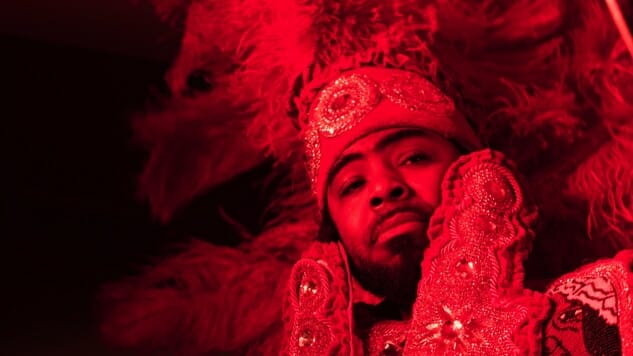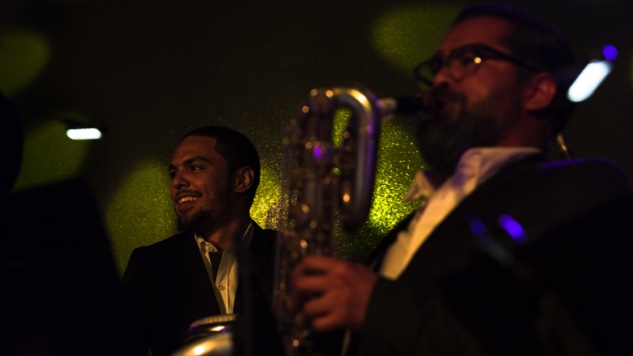Globalfest: Music from All over the World
Photos by Sarah Escarraz
I’ve seen the future of New Orleans music and its name is Cha Wa.
Some forms of New Orleans music, such as trad-jazz and second-line funk, have spread throughout the world. But other forms, such as Mardi Gras Indian chants and street-parade brass bands, remain largely centralized within Orleans Parish. Now a young local, J’Wan Boudreaux, has mashed the latter two genres into one band, named Cha Wa after one of the chants that the Indians shout as they go striding down the street.
And on January 6, the octet was in midtown Manhattan on the second-floor stage at the famous Copacabana as part of the annual Globalfest. But this was not Barry Manilow’s Copa. Boudreaux and his spyboy took the stage in full Indian regalia: 20-inch plumes in a Sioux-like headdress, beaded jackets, breast plates, aprons and leggings—the likeness of a dancing brave beaded against a dark red background and the profile of a chief beaded against a glittery silver background.
Behind them in street clothes was a brass-band sextet: two trombones, trumpet, tuba, guitar and drums. This horn-pumping parade music was significantly different from the percussion-heavy sound of traditional Mardi Gras Indians; the polyphonic horn parts and jazz solos encouraged melodic singing in addition to the usual chanting. Before long, the two costumed singers were twirling and rattling their tambourines as the trombone slides went in and out like pistons.
And Boudreaux, the grandson of the Golden Eagles’ longtime chief, was more than just a bandleader with a clever gimmick; he was a first-rate funk singer who thrived in a sophisticated musical environment. He had grown up suiting up with the Golden Eagles on Mardi Gras Day, but now he was lifting those old street songs to another level.
Cha Wa was just the sort of surprising discovery that makes Globalfest so special. Maybe you never heard of most of the acts, but the festival is so well curated that 90% of the acts are good and 60% are fabulous—high percentages for any festival, even those with better known acts. As a result, Globalfest sells out well in advance.
Shows are going on simultaneously in overlapping sets on all three floors of the Copa complex. Before Cha Wa could even finish, I rushed up to the Rooftop Stage to see Debashish Battacharya, one of the world’s greatest guitarists. He has recorded with John McLaughlin, Jerry Douglas and other Westerners, but his trips to North America are rare.

Debashish Battacharya
In adapting India’s ragas, usually played on sitar, to lap slide guitar, he has changed the sound of both the ragas and the guitar. The tonalities are familiar to anyone who loves steel-string, acoustic guitar, but the complex rhythms and droning subharmonies are entirely Indian. To accommodate the ambitious possibilities in his head, Battacharya invented what he calls the “Hindustani Slide Guitar,” a large dreadnought instrument played horizontally in the lap and featuring 24 strings: eight primary strings, 14 “harp” strings on the player’s side and two “ribbon” strings on the far side.
At Globalfest, Battacharya sat cross-legged on a cushion on a riser, accompanied by his daughter Anandi on vocals and his brother Subhasis on tablas. As Debashish moved his silver cylinder up and down the strings of his custom-made instrument, he created slurs and sighs of ecstatic music that were reinforced by the splattering hits of the hand drums and the wordless moans of the singer.
It was a reminder that major artists live and work beyond the boundaries of not only our nation but also our awareness. Most of us are overstretched for time and can’t research everything—the internet makes the research easier but the available time scarcer. But if you hunger for new artistic experiences, your desire is as likely to be sated by looking to foreigners as by youngsters, especially if you have curators as trustworthy as those at Globalfest to guide you.
Those curators aren’t infallible. The British/Palestinian hip-hop/funk quartet 47Soul was a rousing party band that quickly became as predictable and familiar as its programmed beats. Tennessee singer/songwriter Amythyst Kiah revealed a lustrous voice on songs such as Dolly Parton’s “Jolene” and Rev. Gary Davis’s “Death Has No Mercy,” but her own songs seemed generic by comparison.
On the other hand, Cuba’s Orqesta Akokan was an enjoyable sequel to the Buena Vista Social Club. The younger (but not young) group focused on the mambo sound of the ’50s rather than the son, danzon and cowboy music of the ’30s and ’40s. The 13-piece Akokan ensemble lacked the standout virtuosos of Buena Vista, but they are a working dance band with a male vocalist and a smooth stage act that was thoroughly enjoyable. They were the kind of band that would have been booked by the original Copacabana in the ’50s and ’60s.

Orqesta Akokan
American Indian music is often unsatisfying in a concert setting, because it’s designed to be a participatory art, not a spectator art. Those songs make sense in the context of a tribal ritual but are stranded without context at a nightclub or festival. Jeremy Dutcher, a member of Eastern Canada’s Wolastoquiyik tribe, has solved this dilemma by attaching the striking a cappella songs of his tribal elders to a modern piano trio.
Dutcher handled both the singing and the piano, supported by cellist Blanche Israel and drummer Gregory Harrison. Adding polyphonic harmony via the piano chords and the cello counterpoint made all the difference in the world. Suddenly the high, striking cries of the old songs once again had a context—a different mileu than a campfire ceremony perhaps, but a musical backdrop that made clear the connection between the singer and a community, even if it was a community of fellow musicians. And against that background the powerful melodies stood out as never before.
Also on the Rooftop Stage, Mexican jazz singer Magos Herrera joined the avant-classical string quartet Brooklyn Rider and percussionist Matias Kunzli on the songs from their recent album, Dreamers. A slender, birdlike figure with a red crest of knotted hair, Herrera sported six orange feathers surrounding her right ear and writhed with the serpentine grace of a Hindustani dancer. She sang the politically charged words of Latin American poets and songwriters with a similar flexibility, making their messages seductive rather than combative.

Magos Herrera
The black-clad string players gave the Spanish texts of Octavio Paz, Federico Garcia Lorca, Caetano Veloso and Gilberto Gil a necessary buoyancy, never locking them into a predictable groove or formulaic melody. Instead the two violins, viola and cello were forever shifting their voicings, so the musical ground beneath Herrera’s feet was always slipping, as if to suggest the constant crises that freedom-lovers must confront. She was adroit enough to not only remain upright but to also radiate a reassuring confidence that no matter what the challenges, better days are coming.
This was especially obvious on the set-closer, Mercedes Sosa’s “Balderrama,” a highlight of the Steven Soderbergh´s biopic Che. The Argentinian song describes canal-side drums and guitars playing joyfully in the deep of night, declaring their resistance to an oppressive regime. Singing in Spanish over the ballad’s sumptuous harmonies, Herrera asked, “What will become of us” if the music disappears? It was a question of vital import when the songs were written and perhaps even more crucial today.







































